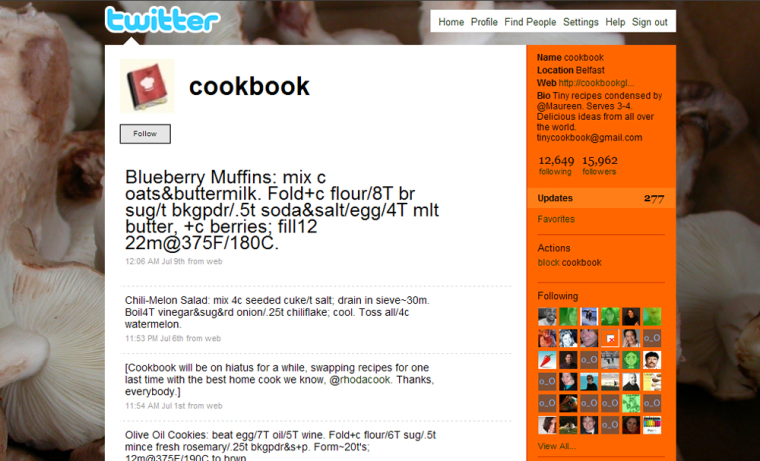R Twttrd recips a gr8 new thing 4 bkg & ckng or r the dirctns 2 confusng for most peeps?
Within the endless streams of bite-size personal updates and random thoughts that populate the Twitter-sphere, now you also can find recipes for dinner, including from pros like Martha Stewart (@marthastewart) and Chicago chef Rick Bayless (@Rick_Bayless).
But there's a catch. Twittered cooking instructions are so compressed they often read like trigonometric expressions. Consider "Heat 3Tdashi, 1/2C miso, 4C H2O" or "Simmer 6 sm leeks w/2T but &1t salt & 1Cwater 10 min".
The recipes, like all tweets, conform to Twitter's ironclad 140-character limit, meaning directions that might fill a page in an old-school cookbook get seriously scrunched.
Critics say the micro-recipes — sometimes called Twecipes — too often are confusing and half-baked. But aficionados call it a modern way to bring cooking to the masses and, besides, puzzling out the instructions is part of the fun.
"Definitely it's a code, it's a hieroglyphic that people have to get over time," says Karen Solomon, a San Francisco-based cookbook author and recipe tweeter. "But so is LOL ... or the emotions like smiley faces that people have been using for years."
Solomon tweets super-short recipes running the gamut from sunchokes to strawberry shortcake as @chef140. Other cooks hitting Twitter with recipes include food columnist Lucy Waverman (@lucywaverman) and Maureen Evans (@cookbook), a prolific amateur cook with more than 15,000 followers.
The recipes are as diverse as the cooks, but the style is the same: extreme brevity. Recipe tweeters ruthlessly exclude all but essential ingredients and basic steps. They rely on the same character-saving shortcuts familiar to cell phone texters. Vowels are trimmed and symbols are common. Tablespoons become "T" and teaspoons "t."
TODAY on Twitter:
A recent tweet for salsa from Bayless, a James Beard award-winning chef, reads in full: Simple Guajillo Salsa:toast 2 clnd guajillos n med-ht oil 4 20-30 sec.Blend w 4 rstd tomatillos,3 rstd garlic,1/2c H20. Salt.
"It is something about bringing recipes down to their bare bones. I hate to use the word intellectual, but it's an intellectual challenge," says Waverman, author of four cookbooks. She'll often post "Twitterized" versions of her recipes in the belief that they're less intimidating.
Waverman's followers include Catherine Kustanczy, a Toronto-area resident who likes the recipes because their abridged style makes it easy to improvise. She also likes that she didn't have to search for a Waverman salmon recipe she cooked recently. It came to her.
"Going through a cookbook takes extra time, whereas it's already on Twitter," Kustanczy says. "It's already there, so you don't have to go and look something up, and look for inspiration."
That spur-of-the-moment quality also worked for Jason Rushin, a San Francisco-area resident who saw Solomon's sunchoke recipe stream by on a Monday afternoon and thought, "Boy, that's interesting. I'll try that tonight." It worked fine.
But even proponents admit the form has limits. Waverman concedes the recipes lack nuance. If a dish includes rosemary, tarragon and thyme, she'll call for them in equal amounts so she won't have to chew up precious characters with three separate measurement instructions.
And some recipes are just untweetable, like lobster Thermidor, which calls for 26 ingredients and 32 steps. Twitter can't handle too many instructions like "pour the cognac in and boil for a minute or two, shaking the skillet."
Solomon doesn't tweet complicated dishes like ravioli. Waverman steers clear of baking recipes because she could never give instructions such as "bake until center is still wriggly."
It's still not clear whether Twitter is an evolutionary step in culinary communication or a passing novelty. Though thousands of people receive recipe tweets, most who answered queries by The Associated Press said they had yet to cook one. Others doubt a recipe that looks like a haiku is of much use. "The fact that you can do it on Twitter doesn't mean that you should do it on Twitter," says Cook's Illustrated magazine publisher Christopher Kimball.
Kimball regularly tweets kitchen tips ("Meatier Burgers? Add 2 tsps miso paste ..." ) and has even edged into recipe territory for simple dishes. But he is wary of posting all but the most basic recipes on Twitter because too much information is omitted and too much can go wrong.
"There's all this information that you leave out, like what is it supposed to look like, what if this doesn't happen, what if you don't have Dutch-processed cocoa?"
Kim McGalliard, a Web consultant from Brooklyn, N.Y., who has cooked all her life, is harsher in her judgment. Twitter recipes are simply too confusing, she says, and they require cooks to go though the extra step of figuring out the recipe. She favors tweets that post links to full recipes.
Of course, the stuff that's left out is part of the charm. Dilys Tosteson Garcia of Los Angeles was struck by the haiku-like quality of Evans' recipes, but understands why some cooks don't like all the missing bits.
"It depends," she says, "on whether you're an artist cook or a scientist cook."
